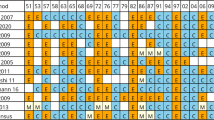Abstract
The El Niño phenomenon is the Earth’s strongest climatic fluctuation on an interannual timescale and has a quasi-global impact, although originating in the tropical Pacific Ocean. A very strong El Niño is recognized to cause extreme dryness and wetness in different parts of the world. We show that all the eight well-documented influenza pandemics, starting from the first certain one documented in ad 1580, originated in China and in Russia, a few years after the occurrence of a very strong or after a prolonged strong/moderate El Niño event. At present, the next El Niño will probably occur at the beginning of 2013 (Mazzarella et al. Theor Appl Climatol 100:23–27, 2010), and this forecast may suggest to be well prepared to take appropriate precautionary epidemiological measures.



Similar content being viewed by others
References
Feng S, Hu Q (2004) Variations in the teleconnection of ENSO and summer rainfall in northern China: a role of the Indian summer monsoon. J Climate 17:4871–4881
Ghendon Y (1994) Introduction to pandemic influenza through history. Eur J Epidemiol 10:451–453
Giese BS, Compo GP, Slowey NC, Sardeshmuck PD, Carton JA, Ray S, Whitaker JS (2010) The 1918/1919 El Niño. Bull Am Met 91:177–183
Health Protection Agency (2009) HPA Weekly National Influenza report. London: HPA. http://www.hpa.org.uk/web/HPAwebFile/HPAweb_C/1259152455206, accessed 31 December 2009
Jeung JWK (2006) A hypothesis: sunspot cycles may detect pandemic influenza A in 1700–2000 a.d.. Med Hypotheses 67:1016–1022
Kilbourne ED (1987) History of influenza. In: Influenza. Plenum Medical Book Company, New York, pp 3–20
Kilbourne ED (2006) Influenza pandemics of the 20th century. Emerg Infect Dis 12:9–14
Mason SJ, Goddard L (2001) Probabilistic precipitation anomalies associated with ENSO. Bull Am Meteorol Soc 82:619–638
Mazzarella A (1998) The time clustering of floodings in Venice and the Cantor dust method. Theor Appl Climatol 59:147–150
Mazzarella A, Giuliacci A, Liritzis I (2010) On the 60-month cycle of multivariate ENSO index. Theor Appl Climatol 100:23–27
Moron V, Ward MN (1998) ENSO teleconnections with climate variability in the European and African sectors. Weather 53:287–295
Oxford JS, Lambkin R, Sefton A, Daniels R, Elliot A, Brown R, Gill D (2005) A hypothesis: the conjunction of soldiers, gas, pigs, ducks, geese and horses in Northern France during the Great War provided the conditions for the emergence of the “Spanish” influenza pandemic of 1918–1919. Vaccine 23:940–945
Potter CW (2001) A history of influenza. J Appl Microbiol 91:572–579
Quinn WH, Neal VT, De Mayolo SEA (1987) El Niño occurrences over the past four and a half centuries. J Geophys Res 92(C13):14,449–14,461
Ropelewski CF, Halpert MS (1987) Global and regional scale precipitation patterns associated with El Niño/Southern Oscillation. Mon Weather Rev 115:1606–1626
Wolter K, Timlin MS (1993) Monitoring ENSO in COADS with a seasonally adjusted principal component index. Proceedings of the 17th Climate Diagnostics Workshop, Norman, OK, NOAA/N MC/CAC, NSSL, Oklahoma Clim. Survey, CIMMS and the School of Meteorology, University of Oklahoma, pp 52–57
Wolter K, Timlin MS (1998) Measuring the strength of ENSO events: how does 1997/98 rank? Weather 53:315–324
Young-Kwon L, Kwang-Yul K (2007) ENSO impact on the space–time evolution of the regional Asian summer monsoons. J Climate 20:2397–2415
Author information
Authors and Affiliations
Corresponding author
Rights and permissions
About this article
Cite this article
Mazzarella, A., Giuliacci, A. & Pregliasco, F. Hypothesis on a possible role of El Niño in the occurrence of influenza pandemics. Theor Appl Climatol 105, 65–69 (2011). https://doi.org/10.1007/s00704-010-0375-7
Received:
Accepted:
Published:
Issue Date:
DOI: https://doi.org/10.1007/s00704-010-0375-7




